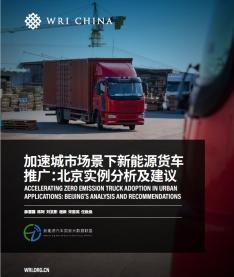Accelerating zero emission truck adoption in urban applications: Beijing analysis and recommendations
With the complete phase out of national new energy vehicle purchase subsidies, Chinese cities need to explore more policy instruments to simulate the adoption new energy trucks (NETs).
With the complete phase out of national new energy vehicle purchase subsidies, Chinese cities need to explore more policy instruments to simulate the adoption new energy trucks (NETs). The study takes Beijing as an example and aims to address: how Beijing can craft policies to further promote NETs, considering different NET models operating in divergent duty cycles by different sizes of operators would have different obstacles with vehicle technologies and costs, to achieve its carbon and air pollutant emission reduction goal, while maintaining the livelihood of small and medium carrier in the freight industry.
The study identifies 12 typical categories of urban freight duty cycles based on local goods and freights statistics (such as light goods and heavy goods) documented by Beijing Transport Institute, mainstreamed NET makes-and-models in China, and annual vehicle kilometers travelled statistics of trucks operated in Beijing summarized by Beijing Transport Institute. Based on NET technical performance analysis and surveys WRI conducted on carriers, further analyzes the technological readiness of NETs and the gaps in total costs of ownership (TCOs) between NETs and ICE trucks for each duty cycle category. The study then identifies the policies that are effective to fill the current (2022—2024) technological and cost gaps of NETs, based on literature review and quantitative analysis.
The above analysis reveals that:
At present (2022—2024), in divergent duty cycles, different NET models have different degrees of technological readiness and TCO gaps:
-Vans: Although the TCOs of electric vans are lower than ICE vans, electric vans still have range limitations. Therefore, OEMs need to tailor the design of the vehicles to fit for urban delivery.
-Light-duty trucks that transport light goods: Affected by range degradation in wintertime, electric LDTs can fulfill a maximum 160-kilometer daily mileage per day (with single charge), and the TCOs of electric LDTs have reached parity with ICE LDTs. Under long-distance duty cycle (daily mileage over 200 kilometers), the TCOs of electric LDTs are still higher. FCEV LDTs, on the other hand, can meet the daily mileage required for all duty cycles, and if the vehicle can be entitled to the city- and district-level Beijing Hydrogen Fuel Cell Electric Vehicle City Cluster subsidies, the TCOs of FCEV LDTs are already lower than that of ICE LDTs. Therefore, FCEVs is a viable alternative for long-distance duty cycle for light good shipments.
-Light-duty trucks that transport heavy goods: Due to considerable payload losses—particularly for FCEVs, both electric and FCEV LDTs have low availability rates and high TCO gaps, compared to ICE vehicles. To overcome the challenges, deregulation of GVWs and technological improvement (energy efficiency improvements and design of 70Mpa/liquid hydrogen storage systems) are entailed.
-Temperature-controlled light-duty trucks: FCEVs are a viable vehicle technology option under this duty cycle, because electric LDTs have lower energy efficiency and higher TCOs. By contrast, FCEVs cannot only fulfill over 260-kilometer daily mileage, but also have lower TCOs than ICE vehicles, especially with the city- and district-level Beijing Hydrogen Fuel Cell Electric Vehicle City Cluster subsidies.
-Heavy-duty trucks that operate within the city: 49t-electric tractor trailers are approaching TCO parity, particularly when daily mileages are over 200 kilometers. This type of trucks is also technological feasible in the drayage duty cycles. However, other electric HDT models would have significant technological and cost challenges.
FCEV HDTs, on the other hand, if not counting in payload losses, they can meet the technological requirements under the urban duty cycle. Further, with the city- and district-level Beijing Hydrogen Fuel Cell Electric Vehicle City Cluster subsidies, the TCOs are lower than ICE HDTs. Therefore, FCEV HDTs become a viable technology option for HDTs, particularly for dump trucks, 42t tractor trailers, and straight trucks, if hydrogen refueling stations are readily available.
According to the above analysis, comprehensive policy recommendations for Beijing to speed up the adoption of NETs at this moment are proposed:
-Promote NETs by duty cycle and avoid competition between BEV and FCEV technologies.
-Optimize the current preferential access policy for NETs.
-Relax gross vehicle weight (GVW) restriction for NETs.
-Provide scrappage or operation subsidies for NETs.
-Expand truck-specific charging and parking facilities.
-Increase the numbers of urban logistic hubs within the city.
